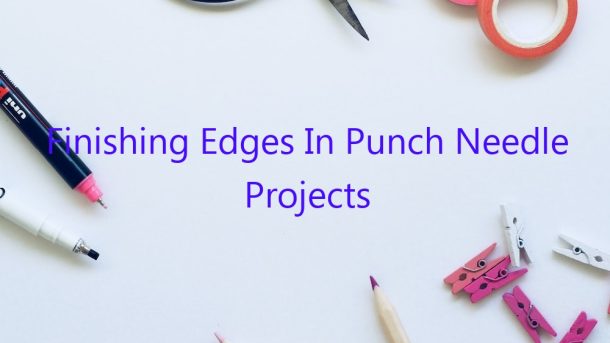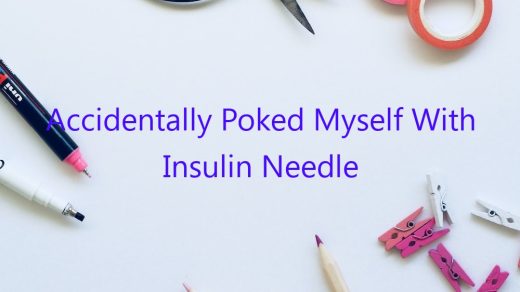Finishing the edges of a punch needle project is a critical step in the process, and can make or break the overall look of the piece. There are a few different techniques that can be used to finish the edges, and each has its own advantages and disadvantages.
The first method is to use a fray check. This is a liquid or gel that is applied to the edge of the fabric to prevent it from fraying. It is a good option for projects that will be washed often, as it will help keep the edges from coming apart.
Another option is to use a zigzag stitch. This stitch is a basic sewing stitch that zigzags back and forth across the edge of the fabric. It is a good option for projects that will not be washed often, as it will help keep the fabric from fraying.
The final option is to use a binding. This is a strip of fabric that is sewn around the edge of the project. It is a good option for projects that will be washed often, as it will help keep the fabric from fraying.
Contents
How do you finish the edge of a punch needle?
There are a few ways to finish the edge of a punch needle project. One way is to use a whip stitch. To do a whip stitch, first make a knot at the end of the thread. Then, poke the needle through the fabric on the front side of the project. Bring the needle back up through the fabric on the back side of the project. Finally, pull the thread tight to close the stitch.
Another way to finish the edge of a punch needle project is to use a blanket stitch. To do a blanket stitch, first make a knot at the end of the thread. Then, poke the needle through the fabric on the front side of the project. Bring the needle back up through the fabric on the back side of the project. Next, make a small stitch in the fabric on the front side of the project. Bring the needle back up through the fabric on the back side of the project. Finally, pull the thread tight to close the stitch.
How do you seal the back of a punch needle project?
When you are finished with your punch needle project, you will need to seal the back to keep the fibers from unraveling. You can use a number of different methods to do this.
One way is to use a hot glue gun. Apply a thin line of hot glue to the back of the project and press it to a piece of felt. Be careful not to get the hot glue on your fingers.
Another way to seal the back is to use a sealant. You can buy a sealant specifically for punch needle projects, or you can use a sealant that is meant for quilting. Apply the sealant to the back of the project and let it dry.
You can also use a stitching method to seal the back of your project. Stitch a line of zigzag stitches around the edge of the project. This will help to keep the fibers from unraveling.
How do you seal punch needle art?
When you’re finished with your punch needle art, you’ll probably want to seal it to protect the fibers and keep it looking nice. There are several ways to do this, and the one you choose will depend on the materials you used and the look you want.
If you used a water-based ink or dye, you can seal the fabric with a water-based sealant. This will keep the colors from fading and keep the fabric from becoming brittle. Options include Mod Podge, acrylic sealant, or spray sealant.
If you used a permanent ink or dye, you’ll need to seal the fabric with a permanent sealant. Options include acrylic sealant, spray sealant, or a sealant specifically made for fabrics.
If you used a hot-melt adhesive, you can seal the fabric by ironing it. Place a piece of parchment paper or a cotton cloth over the fabric and iron it on a medium-high setting.
No matter what type of sealant you use, be sure to test it on a scrap of fabric to make sure it doesn’t change the color or brightness of the punch needle art.
How do you hem a punch needle?
How to Hem a Punch Needle
To hem a punch needle, you will need:
-A punch needle
-A needle
-Thread
-Scissors
Once you have all of your supplies, follow these steps:
1. Cut a piece of thread that is about twice the length of the desired hem.
2. Thread the needle and tie a knot in the end.
3. Insert the needle into the fabric, making sure to leave a tail of about 12 inches.
4. Holding the punch needle with the fingers of your left hand, use your right hand to poke the needle down through the fabric, making a small hole.
5. Pull the thread through the hole until the knot reaches the fabric.
6. Use the punch needle to push the knot back through the hole.
7. Hold the punch needle between your thumb and first 2 fingers, with the thread taut.
8. Use your other hand to poke the needle down through the fabric, making a second hole.
9. Pull the thread through the hole until the knot reaches the fabric.
10. Use the punch needle to push the knot back through the hole.
11. Repeat steps 8-10 until you have reached the desired length of hem.
12. Tie a knot in the end of the thread and trim the excess.
Do you trim punch needle?
Do you trim your punch needle? If you don’t, you should! Trimming your punch needle will help keep it sharp and in good condition.
When you first get your punch needle, it’s a good idea to trim the end off. This will help keep the needle sharp and in good condition. You can use a sharp scissors or a blade to do this.
After you’ve punched a few pieces of fabric, it’s also a good idea to trim the needle again. This will help keep it sharp and make it easier to punch through the fabric.
Be careful not to trim the needle too short. You want to leave enough of the needle to punch through the fabric.
Trimming your punch needle is a good way to keep it in good condition and help you punch through fabric more easily.
How do you seal punch needle coasters?
In this article, we will show you how to seal your punch needle coasters. This process will help to protect your coasters from becoming stained or wet.
You will need the following supplies:
-Ruler
-Punch needle
-Fabric
-Cardboard
-Pencil
-Scissors
-Sealant (optional)
1. Cut a piece of cardboard that is the same size as your fabric.
2. Draw a circle on the cardboard that is the same size as the top of your punch needle coaster.
3. Cut out the circle.
4. Place the fabric on a flat surface.
5. Place the cardboard circle on top of the fabric.
6. Use a pencil to trace around the edge of the cardboard.
7. Cut out the fabric around the traced line.
8. Turn the fabric over so that the wrong side is facing up.
9. Use a punch needle to make a hole in the center of the cardboard circle.
10. Slip the punch needle through the hole.
11. Pull the punch needle tight.
12. Use a sealant to seal the hole in the fabric. (optional)
13. Allow the sealant to dry.
14. Your punch needle coasters are now ready to use!
Do you shave punch needle rugs?
Do you shave punch needle rugs?
This is a question that many people may not know the answer to. There are a few factors to consider when it comes to shaving a punch needle rug.
The first consideration is what type of yarn you are using. A rug made with wool yarn will felt together better if it is not shaved. A rug made with acrylic yarn, on the other hand, will not felt as well, so it can be shaved without any problem.
The second consideration is the design of the rug. If the design is intricate, it is best to not shave the rug. Shaving the rug could distort the design.
The third consideration is how much of the rug you are shaving. If you are just shaving a small section, it is not likely to make much of a difference. If you are shaving a large section, however, you may end up changing the shape of the rug.
So, do you shave punch needle rugs? The answer to this question depends on the type of yarn you are using, the design of the rug, and how much of the rug you are shaving.




